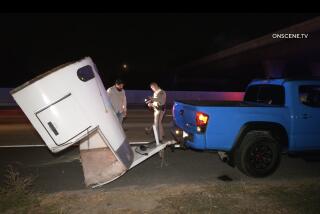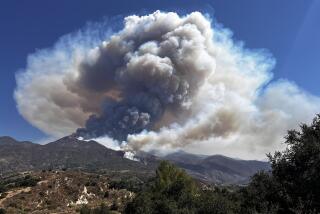Ever Seen a Horse Fly? : Cooperative County Effort Saves Animal That Slipped Down Slope
- Share via
TUSTIN — Ken Sisco knew something was wrong when his Shetland pony started whinnying incessantly Tuesday morning.
But he was even more startled when he walked to the corral behind his Cowan Heights home to discover that one of his other horses, an arthritic 21-year-old, had rolled under the corral and slid 80 feet down a steep slope, landing legs up in a web of manzanita.
Buckwheat’s mishap prompted the Orange County Fire Authority’s first horse airlift. After a grueling four-hour rescue that involved two fire engines, 11 county animal control officers, and the Siscos’ private veterinarian, Buckwheat landed safely in a dusty field behind a Tustin fire station.
“They just tugged and pulled and up she came,” said Capt. Dan Young, a spokesman for the county Fire Authority. “A half-hour later she was eating carrots and apples and saying hello to everyone.”
Young, who spent his morning helping to shepherd the quarter horse to safety, said firefighters “act like they’re a pretty tough breed, but there’s a sensitive side to them. They were all displaying a sensitive side, especially when they ran into the station to get apples and carrots.”
Young said the rescue, free of charge to the Siscos, was the first of its kind for the county, which got its helicopter after, and in part because of, the 1993 Laguna Beach firestorm.
“No one has the resources to fly this horse out, but we do and were glad to get it done,” he said.
The saga began at 8 a.m. Tuesday as Sisco, his wife, Linda, and 17-year-old daughter, Alicia, were sitting at home in this horse country, where houses nonetheless are wedged close together and slopes are perilously steep.
When Pebbles the Shetland pony, herself an aging 16-year-old, alerted the family with her whinnies, Sisco and his wife went out back to check. They were alarmed to count only three horses.
“We had to come up to the second story of the house to actually see down the hill, and we could only see a part of her,” Sisco said. “My wife and I went down to her and she was lying upside down, with her head in a bush.”
Such a slip might have broken bones under most circumstances, but Young said the lush grass that now drapes the hillsides created a slide that cushioned Buckwheat’s fall. In just one week, Sisco said, the hillsides will be razed in anticipation of a dry, hot fire season.
An hour later, about nine firefighters, nine animal control officers and three veterinarians were on the scene, but the horse would not stand up.
“It was pretty evident right from the beginning that there was nothing broken, because she moved all of her legs,” Sisco said. “She was even eating the grass while she was lying down there.”
By 10 a.m., Buckwheat was sedated, tucked firmly into a cargo net, and hooked to the helicopter for the ride of her life: elevation, 1,000 feet.
“The pilot, Andy Campbell, said she would stick her head up to try to see what was going on,” Young said. “Andy’s got thousands of flight hours, but he said this was one of his more unusual flights. It was his first horse.”
Dr. Richard Evans, the county’s chief veterinarian, helped at the scene along with Dr. Julie Ryan, the county’s large-animal vet. Evans lauded the cooperative effort between animal control and fire officials.
While his people have rescued horses from steep slopes before, the helicopter was key to Buckwheat’s rescue, he said.
“I don’t see how in the hell we would ever have gotten the horse out of there without that helicopter,” Evans said. “It’s so steep, and the houses are just so close together. . . . I guarantee this horse wouldn’t have been able to walk up this hill.”
The horse’s owners are grateful, but still worried about Buckwheat. She will stay at another corral for the time being, in an area that is less steep.
“She’s so old, that it could have taken a toll on her. We’ll have to wait and see,” said Sisco, who bought the buckskin horse, with a blonde coat and brown mane, a dozen years ago.
“She is most likely to be very, very sore. (Our vet) said when we were down there that even if we get her out of there, she just may never choose to get up again. Fortunately he was wrong, but he may be right tomorrow.”
More to Read
Sign up for Essential California
The most important California stories and recommendations in your inbox every morning.
You may occasionally receive promotional content from the Los Angeles Times.














